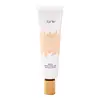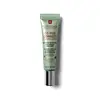What's inside
What's inside
 Key Ingredients
Key Ingredients

 Benefits
Benefits

 Concerns
Concerns

 Ingredients Side-by-side
Ingredients Side-by-side

Cyclopentasiloxane
EmollientIsododecane
EmollientMica
Cosmetic ColorantPolysilicone-11
Polymethylsilsesquioxane
Zinc Oxide
Cosmetic ColorantHexyl Laurate
EmollientPolyglyceryl-4 Isostearate
EmulsifyingCetyl PEG/PPG-10/1 Dimethicone
EmulsifyingAlumina
AbrasiveDiamond Powder
AbrasiveDipalmitoyl Hydroxyproline
Skin ConditioningPEG-10 Dimethicone
Skin ConditioningStearic Acid
CleansingTriethoxycaprylylsilane
CI 77891
Cosmetic ColorantIron Oxides
Cyclopentasiloxane, Isododecane, Mica, Polysilicone-11, Polymethylsilsesquioxane, Zinc Oxide, Hexyl Laurate, Polyglyceryl-4 Isostearate, Cetyl PEG/PPG-10/1 Dimethicone, Alumina, Diamond Powder, Dipalmitoyl Hydroxyproline, PEG-10 Dimethicone, Stearic Acid, Triethoxycaprylylsilane, CI 77891, Iron Oxides
Ethylhexyl Methoxycinnamate 6%
UV AbsorberEthylhexyl Salicylate 2%
UV AbsorberTitanium Dioxide 2.34%
Cosmetic ColorantZinc Oxide 3.84%
Cosmetic ColorantWater
Skin ConditioningCyclomethicone
EmollientDipropylene Glycol
HumectantGlycerin
HumectantPEG-10 Dimethicone
Skin ConditioningMethyl Trimethicone
Skin ConditioningCI 77891
Cosmetic ColorantC12-15 Alkyl Benzoate
AntimicrobialDimethicone
EmollientVinyl Dimethicone/Methicone Silsesquioxane Crosspolymer
Disteardimonium Hectorite
StabilisingMagnesium Sulfate
Butylene Glycol
HumectantCentella Asiatica Extract
CleansingTalc
AbrasiveDimethicone/Vinyl Dimethicone Crosspolymer
Skin ConditioningAluminum Hydroxide
EmollientTrihydroxystearin
Skin ConditioningPhenoxyethanol
PreservativeMica
Cosmetic ColorantMethicone
EmollientPalmitic Acid
EmollientStearic Acid
CleansingEthylhexylglycerin
Skin ConditioningTocopheryl Acetate
AntioxidantPolyester-1
Silica Dimethyl Silylate
EmollientTriethoxycaprylylsilane
Parfum
MaskingHexyl Cinnamal
PerfumingAlpha-Isomethyl Ionone
PerfumingLinalool
PerfumingCitronellol
PerfumingGeraniol
PerfumingEugenol
PerfumingLimonene
PerfumingCI 77492
Cosmetic ColorantCI 77288
Cosmetic ColorantCI 77491
Cosmetic ColorantCI 77499
Cosmetic ColorantEthylhexyl Methoxycinnamate 6%, Ethylhexyl Salicylate 2%, Titanium Dioxide 2.34%, Zinc Oxide 3.84%, Water, Cyclomethicone, Dipropylene Glycol, Glycerin, PEG-10 Dimethicone, Methyl Trimethicone, CI 77891, C12-15 Alkyl Benzoate, Dimethicone, Vinyl Dimethicone/Methicone Silsesquioxane Crosspolymer, Disteardimonium Hectorite, Magnesium Sulfate, Butylene Glycol, Centella Asiatica Extract, Talc, Dimethicone/Vinyl Dimethicone Crosspolymer, Aluminum Hydroxide, Trihydroxystearin, Phenoxyethanol, Mica, Methicone, Palmitic Acid, Stearic Acid, Ethylhexylglycerin, Tocopheryl Acetate, Polyester-1, Silica Dimethyl Silylate, Triethoxycaprylylsilane, Parfum, Hexyl Cinnamal, Alpha-Isomethyl Ionone, Linalool, Citronellol, Geraniol, Eugenol, Limonene, CI 77492, CI 77288, CI 77491, CI 77499
 Reviews
Reviews

Ingredients Explained
These ingredients are found in both products.
Ingredients higher up in an ingredient list are typically present in a larger amount.
Ci 77891 is a white pigment from Titanium dioxide. It is naturally found in minerals such as rutile and ilmenite.
It's main function is to add a white color to cosmetics. It can also be mixed with other colors to create different shades.
Ci 77891 is commonly found in sunscreens due to its ability to block UV rays.
Learn more about CI 77891Mica is a naturally occurring mineral used to add shimmer and color in cosmetics. It can also help improve the texture of a product or give it an opaque, white/silver color.
Serecite is the name for very fine but ragged grains of mica.
This ingredient is often coated with metal oxides like titanium dioxide. Trace amounts of heavy metals may be found in mica, but these metals are not harmful in our personal products.
Mica has been used since prehistoric times throughout the world. Ancient Egyptian, Indian, Greek, Roman, Aztec, and Chinese civilizations have used mica.
Learn more about MicaPeg-10 Dimethicone is silicone with conditioner and emulsifier properties. It mostly acts as an emollient in skincare and and humectant in haircare.
According to the manufacturer, acidic formulations decrease the stability of this ingredient. It works best in neutral or near neutral formulations.
Stearic Acid is a fatty acid. It is an emollient, emulsifier, and texture enhancer.
As an emollient, stearic acid helps soften skin. It aids the skin's protective barrier by preventing water loss. It also provides a gentle cleansing effect without stripping away natural oils.
Stearic acid may also be used to enhance the texture of products. It can add volume and stabilize ingredients such as water and oil. This can help water and oil ingredients from separating.
Sources of stearic acid include animal or vegetable fats/oils such as coconut or shea. It can be naturally found in butter, cocoa butter, shea butter, vegetable fats, and animal tallow.
This ingredient may not be Malassezia folliculitis, or fungal-acne safe.
Learn more about Stearic AcidTriethoxycaprylylsilane is a silicone used to bind and stabilize ingredients.
As an emulsifier, it helps prevent ingredients from separating. This can help elongate the shelf life of products.
Triethoxycaprylylsilane is often used to coat mineral sunscreens ingredients to help give a better feel. It also helps reduce oxidative stress in sunscreens.
Learn more about TriethoxycaprylylsilaneZinc Oxide is a mineral broad-spectrum UV filter; it is the broadest UVA and UVB reflector approved by the FDA. It also has skin protectant and skin soothing properties.
Zinc oxide is one of the most effective broad-spectrum UV filters. It protects against UVB, UVAII, and UVAI. In comparison to its counterpart titanium dioxide, zinc oxide provides uniform and extended UVA protection.
Another great benefit? This ingredient is highly photostable so it won't degrade easily under sunlight.
A common myth is that mineral UV filters are widely believed to primarily reflect UV light.
However, modern research shows titanium dioxide absorbs UV radiation like chemical filters (~95% absorption & 5% reflection).
Zinc oxide has great skin soothing properties so you'll likely find this in sunscreens formulated for sensitive skin or babies/children. It is unlikely to cause "eye sting" like other sunscreen ingredients.
Regulatory agencies consider zinc oxide to be non-toxic and safe. It has also been shown to not penetrate the skin.
Unfortunately, this ingredient does leave a visible white cast. This is why mineral sunscreens are often less cosmetically elegant than chemical or hybrid ones.
In cosmetics, zinc oxide can be found in both non-nano and nano-sized forms. The nano version is used to reduce white cast and improve the texture of sunscreen formulas.
There are ongoing concerns surrounding nano-zinc oxide's impact on marine ecosystems and whether it can be absorbed into skin.
Regarding marine ecosystems and coral reefs, there is no conclusive evidence that any form of zinc oxide (or any other sunscreen ingredients) will cause harm. The science is still developing but many consumers are keeping a close eye on this issue.
Please note, many destinations have reef-safety sunscreen rules. For instance, the U.S. Virgin Islands advises all visitors to use non-nano mineral sunscreens.
There has also been some stir about whether micronized or nano zinc oxide has potential photoxicity and absorption through the skin/lungs.
An in-vitro (done in a test tube or petri dish) study demonstrated micronized zinc oxide to have potential phototoxicity. There's no need to fret; the EU Commission's Scientific Committee on Consumer Safety has stated, "The relevance of these findings needs to be clarified by appropriate investigations in vivo." Or in other words, further studies done on living organisms are needed to prove this.
Current research shows zinc oxide nanoparticles do not penetrate intact or sunburned skin. They either remain on the surface or in the outermost layer of dead skin (stratum corneum).
Zinc oxide is one of only two classified mineral UV filters with titanium dioxide being the other one.
Fun fact: Zinc has been used throughout history as an ingredient in paint and medicine. An Indian text from 500BC is believed to list zinc oxide as a salve for open wound. The Ancient Greek physician Dioscorides has also mentioned the use of zinc as an ointment in 1AD.
Learn more about Zinc Oxide